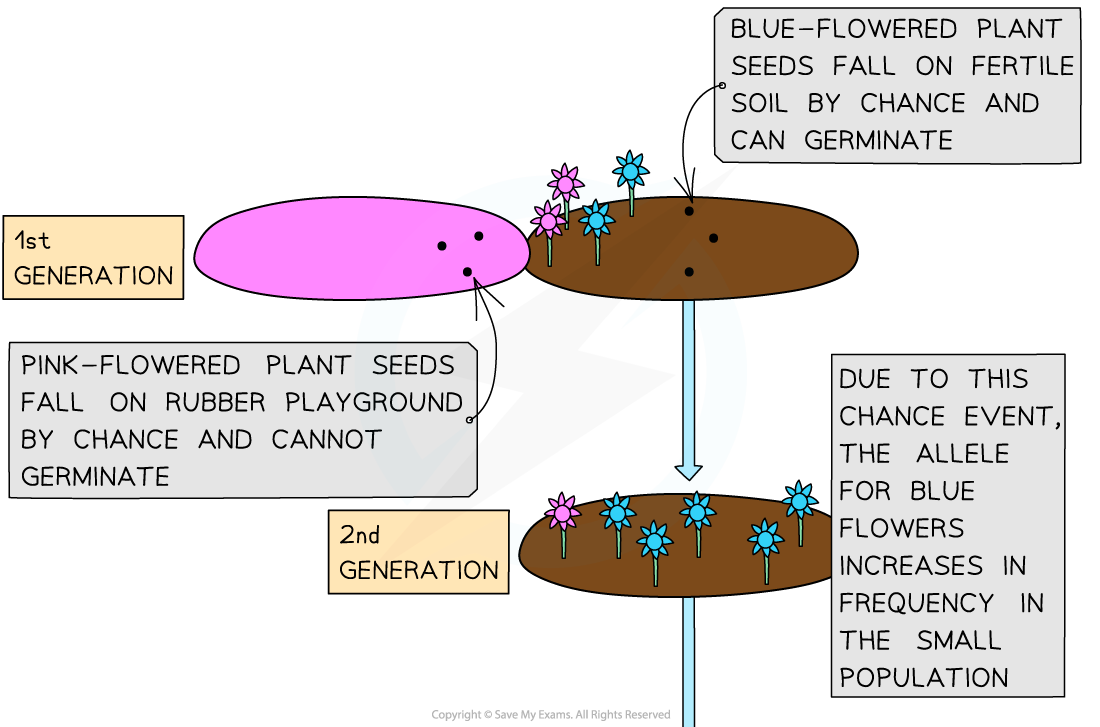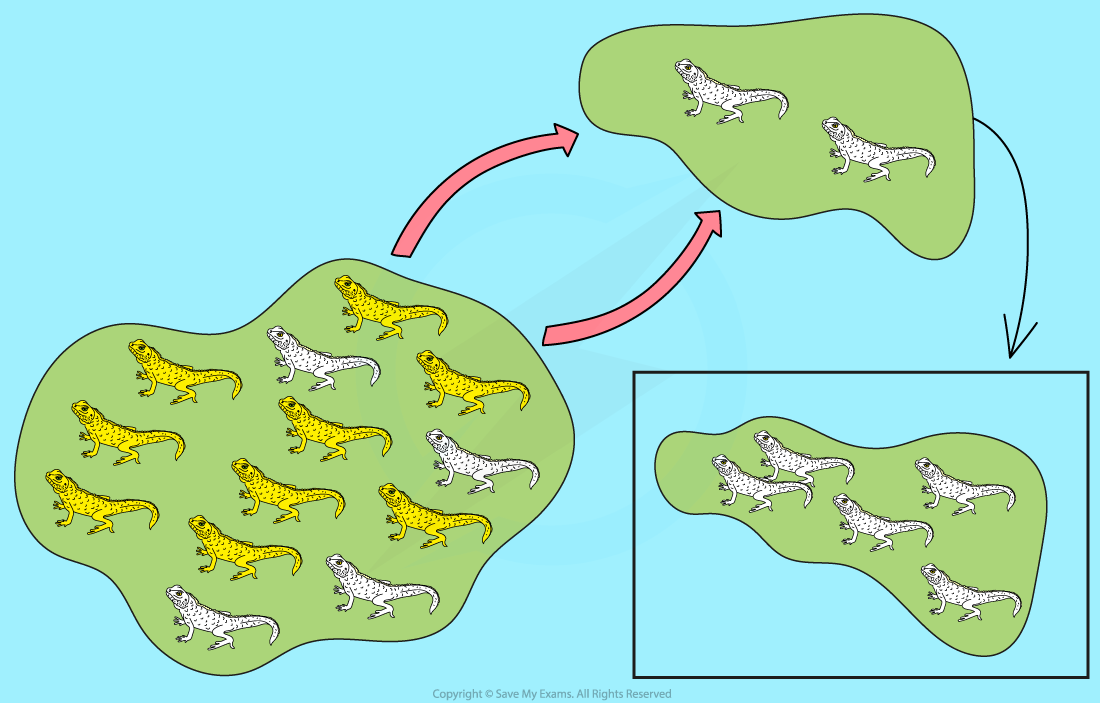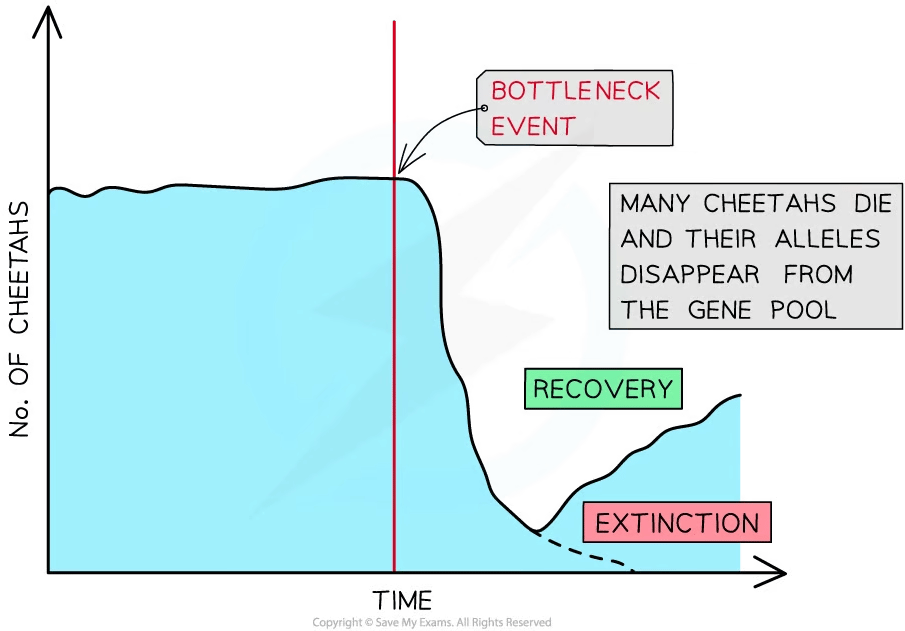Natural Selection: Changes in Allele Frequencies (Cambridge (CIE) A Level Biology): Revision Note
Exam code: 9700
Natural selection: changes in allele frequencies
Evolution involves changes in allele frequencies over time
This can be caused by natural selection
Selection pressures (caused by abiotic and biotic factors) decrease the likelihood that certain individuals with specific alleles survive to reproductive age, preventing them from passing on their alleles to their offspring
In addition to natural selection, it is also possible for allele frequencies to change as a result of chance; this can occur due to a process known as genetic drift
Other processes that can cause changes in allele frequencies due to chance events include
The founder effect
The bottleneck effect
Natural selection
When a new allele arises in a population or a change in the environment occurs, directional selection can happen
Directional selection produces a gradual change in allele frequencies over several generations
There is always phenotypic variation within a population
There is a selection pressure in the environment, e.g. the presence of a predator
Some individuals in a population may have a phenotype that aids their survival in the presence of a selection pressure
The phenotype is produced by particular alleles
Individuals with the favoured phenotype are fitter and so more likely to reproduce and pass on the advantageous alleles to their offspring
Those who do not possess the advantageous allele or phenotype are less likely to survive and pass on their alleles to their offspring
So over time and several generations, the frequency of the advantageous allele increases and the frequency of other alleles decreases
Genetic drift
When a population is very small, chance can affect which alleles get passed on to the next generation
Meiosis results in haploid gametes, meaning that a fertilisation event only passes on half of the alleles of an individual
The half that gets passed on is the result of random fertilisation, and the other half of the alleles may not make it to the next generation
Over time some alleles can be lost or passed on purely by chance; this is genetic drift
Genetic drift is more likely to affect allele frequencies in a small population
eg. if a coin is tossed 10 times it is reasonably likely that heads will not come up at all, whereas if a coin is tossed 100 times and heads doesn't come up at all you would think you had a faulty coin!
Similarly, the chances of a certain allele simply being lost by chance as a result of random fertilisation are much greater if only 10 pairs of birds are breeding than if there are 100 pairs of birds breeding
Example: genetic drift in plants
In a small population of five plants growing near a playground with a rubber floor, three of the plants have blue flowers and two of the plants have pink flowers
By chance, most of the seeds from the pink-flowered plants end up on the rubber floor of the playground while all the seeds from the blue-flowered plants land on fertile soil where they are able to germinate and grow
Note that the seeds from the pink flower do not fall on the impermeable surface because of any disadvantageous allele in the plant's genome, but purely by chance, eg. because of a gust of wind or a passing animal
If this happens by chance over several generations the allele for the pink flowers may be lost from this population


The founder effect
The founder effect occurs when a small number of individuals from a large parent population start a new population
The founder effect can come about as the result of chance
E.g., a chance event such as a storm may separate a small group of individuals from the main population
As the new population is made up of only a few individuals from the original population, only some of the total alleles from the parent population will be present
In other words, not all of the gene pool is present in the smaller population
Because the population that results from the founder effect is very small it is more susceptible to the effects of genetic drift
Example: the founder effect in lizards
Anole lizards inhabit most Caribbean Islands and they can travel from one island to another via floating debris or vegetation
A small number of lizards may be separated from the main population on a larger island and carried away to a smaller island by a chance event such as a large ocean wave or a storm
The lizards arriving at a new island may only carry a small range of alleles between them, with many more alleles present in the lizard population on the original island
eg. the lizards on the original island could display a range of scale colours from white to yellow and the two individual lizards that arrived on the island may have white scales
This means that the whole population that grows on that island might only have individuals with white scales
In comparison, the original island population has a mixture of white and yellow-scaled individuals.
If the yellow allele were recessive and present as a single copy in the original two lizards that arrived on the island, the chance of it being lost as a result of genetic drift is increased due to the small size of the gene pool

The bottleneck effect
The bottleneck effect is similar to the founder effect
It occurs when a previously large population suffers a dramatic fall in numbers
A major environmental event can greatly reduce the number of individuals in a population which in turn reduces the genetic diversity in the population as alleles are lost
The surviving individuals end up breeding and reproducing with close relatives
Example: bottleneck effect in cheetahs
A clear example of a genetic bottleneck can be seen in cheetahs today
Roughly 10,000 years ago there was a large and genetically diverse cheetah population
Most of the population was suddenly killed off when the climate changed drastically at the end of the Ice Age
As a result, the surviving cheetahs were isolated in small populations and lots of inbreeding occurred
This meant that the cheetah population today has a lack of genetic variation
This is problematic for conservation as genetic variation within a species increases the likelihood that the species is able to respond in the event of any environmental changes
Remember the environment exerts a selection pressure on organisms

Process | Result |
|---|---|
Natural selection | Selection pressures produce a gradual change in allele frequencies over several generations. |
Founder effect | Changes in allele frequencies occur in a different direction for the newly isolated small population in comparison to the larger parent population due to chance. |
Genetic drift | Gradual change in allele frequencies in a small population due to chance and not natural selection. |
Bottleneck effect | Reduction in the gene pool of a population due to a dramatic decrease in population size. |

Unlock more, it's free!
Did this page help you?